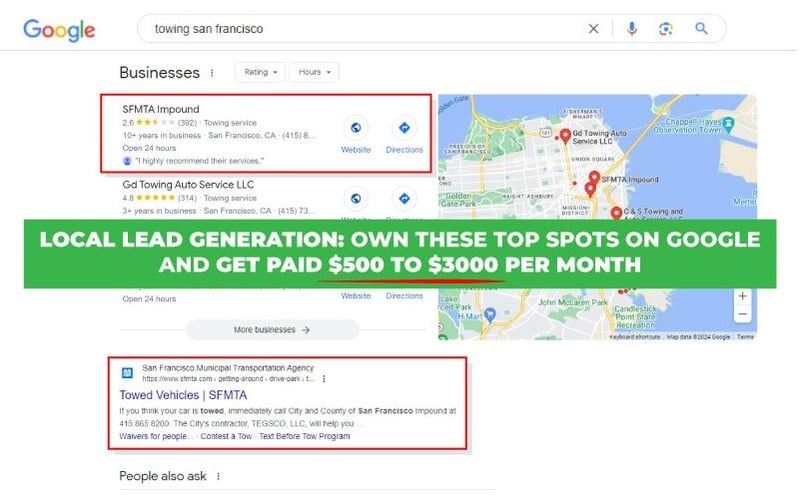Justin Phillips’ Last Ecom Training Review — 3 Major Reasons Dropshipping is a Hassle & Alternatives Explained
Updated On

The Last Ecom Training by Justin Phillips is a course that teaches people how to make money in ecommerce from start to scale using Justin’s three secret strategies. His three strategies include cloning successful e-commerce brands, reaching out to influencers to help you increase your brand awareness and sales, and generating traffic on social media.
In my experience, dropshipping as taught by Last Ecom Training is like the Titanic’s lifeboats that are designed to function under ideal conditions but collapse the moment things get rough. It reflects dropshipping thin margins that leave no safety buffer, so when product costs rise or refunds hit, the profits sink fast. Most of your budget will go to marketing, which reminds me of The National Lottery, where success relies on continuous bets. You keep spending on ad campaigns hoping that the sales it produces will cover all your expenses.
In this review, we’ll break down the pros and cons of the program, explore Justin’s business journey, and uncover why dropshipping is such a high-maintenance model despite its income potential. Finally, we’ll compare Last Ecom Training to local lead generation which is a business model that delivers predictable, passive, and scalable income without inventory, refunds, or paid ads.

What Are the Pros and Cons of Last Ecom Training?
Pros:
- Justin has made over 7-figures in the world of eCommerce.
- You will learn all the steps Justin takes in his e-commerce business to build and scale your business.
- Coaching calls hosted by Justin.
- Justin reveals how he reaches out to famous personalities on Instagram without appearing “salesy”.
Cons:
- Dropshipping is high maintenance and doesn’t offer you a passive income whatsoever.
- You can’t predict your income with an ecommerce business.
- Paid traffic on Facebook, TikTok and even Google ads are getting more expensive as time passes.
- Unhappy customers are an inevitable part of the ecommerce world (refunds & returns).
Price: The Last Ecom Training costs $1,497.
Refund Policy: 30-day, action-based refund policy.
Training; Video training with several modules.
Group: Facebook group for support.
Origin: Justin released The Last Ecom Training in 2021.
Reputation: Justin has an excellent overall reputation because of the success he’s had. It has shown in the way he carries himself in business and with his partnerships and clients. He and Corey have been invited to speak on podcasts such as Earn Your Leisure, Dormtainment, and Social Proof. The only negative response has been that it takes too long for customers to receive their merchandise after they order. Fox 5 Atlanta reported that thousands of customers were upset it took so long to receive their merchandise after they ordered. Justin and Corey admit they took on orders for products they didn’t have.
What Are the 3 Major Reasons Dropshipping Is a Hassle?
1. Expensive Paid Ads
To be successful with dropshipping, you need to run paid ads so you can generate more sales. The most popular social media platforms to run ads on are Facebook and TikTok because of the millions of users each platform has. The problem with running ads on these platforms is that there is a lot of competition. Many ecommerce businesses run ads for clothing and other products or services which makes paying for traffic expensive. The cost of running ads is rising each year. On Meta alone, the CPM has increased 61% each year. On TikTok, the CPM has gone up 185% each year. This trend is only going to continue making running ads for your ecommerce store more difficult in the coming years.
2. Product Research is Time Consuming and Expensive
If you aren’t constantly conducting product research, you won’t be successful in the business for long, or at all. You have to always look for the next potentially profitable product and when you do, look for the next. This is because eventually products stop being trendy at some point. You may find or create a product like Justin and Corey did with the Support Black Colleges merchandise, but those are few and far between, if at all. This phase of your ecom business is time consuming and expensive because you have to run several paid ads to test the market and see if those products are worth your time. You may spend days and hundreds of dollars just to realize a product won’t be good enough.
3. Refunds and Returns on Merchandise
When selling physical products, it’s highly possible that some of your customers may want refunds or to return your products because they aren’t happy with them. It can be because the quality of the products are sub-par or shipping times can be long. This is a headache because then you need to give money back to customers, which will force you to coordinate the shipping for the return with your supplier. Having to give many refunds will cut into your profits and doesn’t look good if you ever find yourself applying with a new merchant processor during your underwriting process.
What Is the Last Ecom Training Overview?
1) How to Clone any 6-7 Figure Brand Website in Less Than 1-minute For Free
The first secret that Justin shares is to find other profitable Shopify websites and see what it is they are doing that allows them to be profitable. After you take not of what they are doing, you then go in and model your store the same.
2) Reach Out Method That Makes it Easy to Have Huge Influencers Support Your Business For Free
The second secret is influencer marketing. Justin shows you how to reach out to influencers in a way that doesn’t appear “salesy”. Justin is transparent in how and what he says to influencers or people who are close to influencers that will get them to respond to you.

3) Hack to Get the Right Traffic to Your Website for Free
The last secret is all about how to generate leads on Facebook and TikTok to increase your revenue.
Who Is Justin Phillips?

Justin Phillips is a 7-figure ecommerce entrepreneur from Houston, Texas. He attended Howard University for a bachelor’s in audio production. He was raised by a single mother who worked 3 jobs. She would work a 9-5 job, do real estate and bottle service. As a teenager, Justin would throw teen parties where his mother worked.
In 2012, he met his business partner, Corey Arvinger, and they founded the now famous Support Black Colleges clothing brand to support HBCUs (Historically Black College or Universities).

In 2013, Justin worked as a brand ambassador for Coca-Cola and then began making money as a digital marketer. In 2015, he worked as the social media strategist for HapApp. The year after, he continued working in the digital marketing space for companies like Social Wage and Yunmai. In 2016, he founded Apex Media, an online media and marketing agency.
All the while Justin did all this work, he and Corey built up the Support Black Colleges brand to where they made $1 million in one day on Black Friday. Celebrities and athletes like Lil Baby, Gunna, Teyana Taylor, Chris Paul and Donovan Mitchell have supported the brand.
On social media, Justin has over 643K followers and all his content revolves around merchant suppliers, vendors, manufacturers, and more.

Justin has also written The Last E-commerce eBook You’ll Ever Need, which shows you how to grow your Shopify brand.

Justin Phillips Net Worth
Justin Phillips has an estimated net worth of between $7 million and $11 million if you factor in the over $7 million he has done in Shopify sales and the money he is making from the thousands of students who have bought his course.
How Justin Philips Made $10.1 Million Before Turning 30

Justin’s Background and Story and How the Business is Doing Today
Justin started his ecom business with only $100. He didn’t have the support of a family and with no financial backing, he had to self-learn the clothing business and build it from scratch. His businesses, including the Support Black Colleges Brand, are now worth $10 million.
Justin’s Top Business Challenges and Lessons
Managing money was one of the biggest business challenges for Justin. There was a time when his business funds went from $1.1 million to $112,000. At this time, he had to rethink his strategies and take plans on how to avoid the same situation again.
He also realized the importance of having the right mindset in business. When the business wasn’t doing well, he questioned his self-worth. Separating his business from his personal life helped him gain a balanced view of success and failure.
How Justin Overcame the Business Challenges
Starting a clothing business with limited capital, Justin had to be smart in using his resources. He leveraged his social media presence to advertise his brand without spending too much.
Justin focused in creating unique designs that will set him apart in a saturated market. According to him, the brand is more than just a logo. The clothes should be high-quality and useful.
What’s not mentioned in the interview: Clothing brands have low profit margins. Although the usual gross profit margin is around 53%, net profit can go as low as 7%.
What Are The Last Ecom Training Alternatives?

Supreme Ecom Blueprint by AC Hampton is an ecommerce training course that teaches you how to build and scale your Shopify store. You learn the most current strategies and are provided you with the tools you need to run your business. You also learn how to leverage Facebook advertising and you get a list of over 950 profitable product ideas that will help you save time in your product research phase.
Price: Supreme Ecom Blueprint costs $597.
More Info: Supreme Ecom Blueprint Review
Final Verdict: Is The Last Ecom Training the Best Way to Build Income Online?
The Last Ecom Training is not the best way to build ]income online if you want low maintenance and high predictability. While Justin Phillips shares strategies from his own ecommerce success, the model itself is volatile, requiring constant ad testing, customer support, and trend-chasing to stay profitable. The real cost isn’t just in money, but in time, risk, and emotional bandwidth.
How Does Dropshipping Compare to Local Lead Generation?
Dropshipping is harder to sustain than local lead generation because it relies on paid ads, product trends, and unpredictable fulfillment logistics. Comparing dropshipping to local lead generation is like Zamboni runs versus Evernote’s auto-sync. A Zamboni demands constant refilling, an operator on standby, and repeated short bursts of work that momentarily fix the ice. It’s like dropshipping where every sale often eats fees, shipping, and returns, so you’re repeatedly spending effort and cash for fleeting gains. Evernote quietly syncs and files every note once you’ve set it up. It mirrors local lead generation sites that continue to attract leads with little daily effort, low ongoing fees, and no constant marketing buy-ins.
What Makes Local Lead Generation a Sustainable Business Model?
Local lead generation is a sustainable business model because it removes the operational chaos tied to physical products and paid ads. It is built on ranking simple websites that deliver leads to local service providers, creating predictable, hands-free revenue.

One of my clients is Santa Ana Elite Roofing, 135 East Garry Avenue, Santa Ana, California 92707, 714-581-9695, https://santaanaeliteroofing.com/. I earned $3.5K from 5% commissions when 3 of my high-ticket leads closed for $70K in 1 month.
If you’d rather own a digital asset that works for you without chasing the next winning product, explore how local lead generation creates leverage from day one.

Follow Me
Ippei Kanehara
Founder/CEO
$52K per month providing lead generation services to small businesses
Ippei.com is for digital hustlers, industry leaders and online business owners.
His #1 online business recommendation in 2024, is to build your own lead generation business.